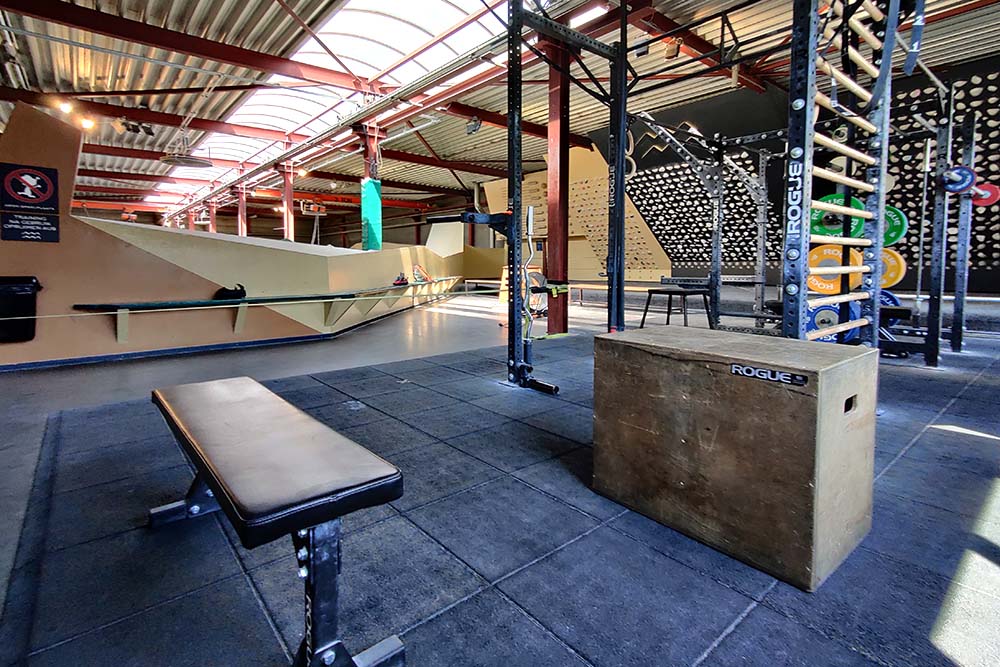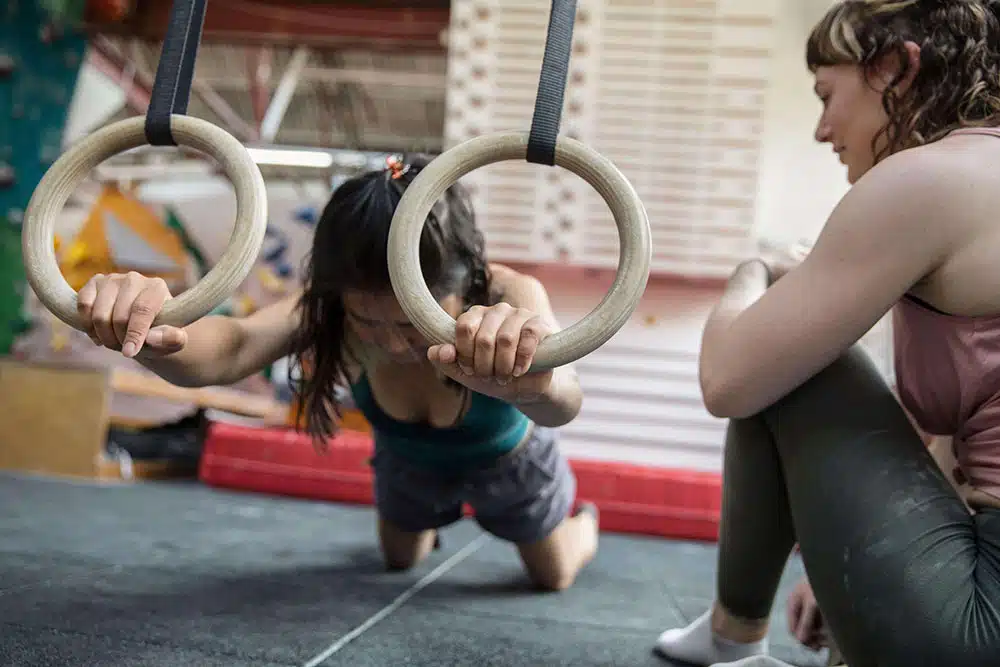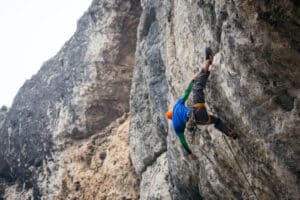When I first started climbing over a decade ago, the climbing gym was the only gym. The other “gym,” with all the mirrors and heavy objects, was a place I did not go. I was not interested in pushing or pulling heavy objects around the room. I thought I was much better off just climbing.
However, nowadays, I realize I may have been cutting myself short. By not spending time training in the weight room, I missed out on the benefits of strength training. Fortunately, I am a more balanced athlete now, and I understand that strength training can complement my climbing-specific training.
If the old me sounds like you right now, then keep reading. I’m hoping this article will help shed light on what strength training is and how you can mix it into your climbing time to help you climb harder.
What is Strength Training for Climbing?

Strength training, also commonly referred to as resistance training, is a mode of exercise where you force your muscles to contract against an outside force or resistance. There are many different types of outside resistance your muscles can work against.
- Body weight
- Resistance bands
- Medicine balls
- Dumbells and other freeweights
- Weight machines
Strength training for climbing, then, is resistance training that specifically targets parts of the body (i.e., different muscle groups) that are applicable to the sport of rock climbing.
For example, it’s common knowledge that pulling muscles like the biceps are critical for climbing. Therefore, a strength training exercise that works the bicep muscles specifically can help you improve your climbing. Similarly, strength training exercises that force your core muscles to work against resistance are also very helpful for climbing.
Benefits of supplemental strength training
When you put your body in a situation to push, pull, and generally move against resistance during a strength training routine, you inevitably get to experience a host of benefits.
- Increased muscle mass: when you strength train, you put your body in a process called muscular hypertrophy. Hypertrophy stresses the soft tissues in the part of your body that you’re working on, breaking the tissue down and subsequently triggering the body to rebuild bigger and stronger tissue in its place, increasing muscle size.
- Better joint flexibility: traditionally, static and dynamic stretching have been thought of as the only way to improve flexibility. However, research shows that resistance training can also improve flexibility
- Stronger bones: muscles are not the only things that are stressed during a weight training session; the bones in your body are also stressed. By stressing your bones via resistance training, you can improve bone density.
- Weight management: strength training helps you lose weight and manage your weight moving forward. By building muscle, you also increase your metabolic rate, effectively helping you burn more fat than muscle.
- Improves balance: strength training exercises build muscle size and improve your body mechanics. This leads to improvements in your balance as well as overall mobility.
General Strength Training vs. Climbing-Specific Training
It’s important to understand that strength training for climbing is different than climbing-specific training. Overall, general strength training enhances your foundation of functional strength and many other aspects of your body, as I listed above. Generally speaking, it helps you push, pull, or move heavier objects and have a more powerful body.
On the other hand, climbing-specific training is targeted towards aspects of your body specifically related to climbing. Generally, we categorize climbing-specific training into strength, power, and power-endurance categories. In addition, climbing-specific strength is normally mostly thought of as finger and forearm strength.
One way you can think of it is like this:
All climbing-specific training is strength training, but not all strength training is climbing-specific.
Let me explain.
Climbing itself is a form of strength training. When you climb, you are resisting the gravitational pull on your body weight to ascend the wall. Therefore, climbing, which in itself is climbing-specific, is also a form of resistance training. The same can be said for other exercises we think of as climbing-specific, like hangboard routines and campus board workouts. Both hang boarding and campusing are specific to climbing. However, they rely on bodyweight resistance (if not more); therefore, they are also considered strength training.
On the other hand, plenty of non-climbing-specific resistance training exercises build strength. For example, working out your pushing muscles via a bench press builds overall strength and explosive power in your chest. More power is always good for climbing. However, I would not say that the bench press is a climbing-specific exercise.
Crucial Aspects of Strength Training
Most climbers can get pretty far in their climbing career simply by training in the climbing gym and rock climbing outside. In other words, by only doing climbing-specific exercises. However, eventually, most climbers reach a plateau in their climbing development where their progress evens out and ceases to improve.
At this point, many climbers simply enhance their climbing-specific routines. Designing a harder climbing-specific training routine is an effective way to progress past your plateau. In addition, learning how to incorporate traditional resistance training into your workouts is another fantastic way to get back to improving.
If you want to design a strength training regiment to complement your climbing, I recommend you consider the following points which I’ll discuss:
- The importance of progressive overload.
- Muscle groups to hit.
- Climbing discipline specific goals.
- Designing your training schedule.
The Importance of Progressive Overload
The reason you probably hit a plateau in your training is probably because your climbing lacked progressive overload. Progressive overload is a concept where you increase the intensity, weight, or volume of your training over time. Typically, progressively overloading your workout by 10% (or less) each week is an effective strategy for continuing to progress and avoid plateaus.
For climbing training, progressive overload could mean adding time to hangs on the hang board. For strength training, progressive overloading can look like increasing repetitions or adding more weight to your lifts.
For example, if you previously performed three sets of 12 repetitions but can now do 15 to 20 repetitions, it’s time to progress. You can progressively overload by adding 5-10% more weight.
Key Muscle Groups to Hit
Despite strength training not being considered climbing-specific, you can still work out key muscles that you frequently deploy while rock climbing. By strategically targeting muscles you deploy in climbing, you can build more strength, which will translate to your climbing.
Upper Body Muscles
- Forearms
- Biceps
- Latsissimus dorsi
- trapezius
- Deltoids
- Rhomboid
- Rotator cuff muscles like the teres minor, subscapularis, supraspinatus, and infraspinatus
Core Body Muscles
- Rectus abdominis
- External obliques
- Internal obliques
Lower Body Muscles
- Quadriceps
- Hip flexors
- Calves
Climbing Discipline-Specific Goals
Although general resistance training may not be climbing-specific, it will certainly help your climbing. For it to be the most effective, it can be helpful to create strength training goals specific to the discipline of climbing you practice the most.
For example, a boulderer who desires more explosive power in their legs may incorporate explosive lifts into their training, like squats, leg presses, or dumbbell (or barbell) snatches.
Another training example is route climbers who want to train for a big multi-pitch. They may want to include lightweight upper-body exercises without resting to boost the endurance multi-pitch routes required. Or they might train their lower body with lunges and step-ups to train the many muscles in their legs to be stronger for long approaches.
Developing a Well-Designed Training Schedule
One of the major keys to success for most strength training climbers is to develop a well-devised training schedule. A schedule or training regimen will function as a roadmap you can follow, helping you hold yourself accountable, stay motivated, and track your resistance training and climbing performance.
The training regimen you design should be unique to you. It should cater to your goals, match your abilities, include exercises you enjoy, and accommodate your schedule. Developing a strength training schedule is beyond the scope of this article, but I do want to mention something to keep in mind as you build your schedule in your free time– the interference effect.
The interference effect is the idea that if you train different modalities concurrently or simultaneously, i.e., strength and cardio, you interfere with your progress more so than if you were to train strength and cardio separately. In the past, it was generally understood that the interference effect played a role with athletes with concurrent training regiments. However, nowadays, it seems like science is leaning more so toward the idea that the interference effect is not such a big deal, especially for most average or recreational athletes (as opposed to professionals).
In other words, for athletes like you and me, devising a training regiment that includes different training blocks with strength, cardio, and climbing-specific exercises is perfectly okay. With that being said, it still is a good idea to prioritize your training based on your goals and climbing preferences. For example, cardio is way more helpful for sport climbers who love long routes than boulderers. So while a sport climber may do cardio on a rowing machine work every week, a boulderder may only row every other week.
Even more important is avoiding overtraining. When you begin to combine strength training with your normal climbing routine, it can be easy to fall into the trap of overtraining. When you overtrain, you open yourself up to injury and stunt your body’s ability to rest and recover. This will stop you from progressing and climbing harder more so than the interference effect from concurrent training.
Strength Training Tools
If you are brand new to strength training, it can be hard to know what to do when you get to the weight room or how to design a workout. You know you’re supposed to lift heavy objects, but you don’t know why or how.
Here are three couple common ways to organize a weight training routine. These are just examples– the amount of weight and repetitions should be changed to match your ability level.
- Pyramid Sets
Pyramid sets incrementally increase the resistance for each working set. Typically, in a pyramid set, the number of repetitions will decrease as the load increases.
Example Pyramid Set for Bench Press
- 125 pounds x 12 repetitions
- 145 pounds x 10 repetitions
- 160 pounds x 8 repetitions
- 175 pounds x 6 repetitions
2.) Drop Sets
Drop sets are another effective strength training tool. Drop sets decrease the resistance for each working set. As the resistance decreases after each set, the number of repetitions increases. Typically, drop sets are used as the finishing exercise in a workout. There should be little to no rest between sets.
Example Drop Set for Quad Extensions
- 100 pounds x 5 repetitions
- 80 pounds x 6 repetitions
- 60 pounds x 8 repetitions
- 40 pounds x 10 repetitions
3.) Super Sets
Lastly, super sets. Super sets are one of the most commonly used methods for resistance training. Super sets consist of combining at least two exercises (or more) one after the next, with little rest between sets. The exercises you combine should work for complimentary muscle groups (antagonist supersets), for example, chest and back, triceps and biceps, or hamstrings and quads. But you can also target the same muscle group (agonist super sets).
Example Super Set Combos for Chest and Back
- Barbell row and bench press
- Lat pulldown and incline dumbbell press
- Seated cable row and standing cable chest fly
Sample Strength Training Workout
In an effort to present you with the most helpful information possible, I reached out to a friend of mine and Doctor of Physical Therapy, Rob Scrivner. Rob specializes in working with athletes and climbers in particular. His private practice, Alpen Strong Physical Therapy, is located in Estes Park, Colorado.
The following exercises are a sample strength training workout created by Rob for one of his rock climbing clients. Remember, these are just samples, you may need to adjust the weight or number of sets and repetitions.
Strength and Conditioning Sample Workout
- Deadlift: 240 pounds, 3 sets x 5 repetitions
- Dumbbell External Rotation: 15 pounds, 3 sets x 15 repetitions
- Bench Press: 140 pounds, 3 sets x 6 repetitions
- Side-Plank with Powell Raise: 10 pounds, 3 sets x 12 repetitions
- Sumo Squat: 35 pounds, 3 sets, 12 repetitions
- Bent Over Row: 75 pounds, 3 sets, 10 repetitions
Pure Strength Sample Workout
- Deadlift: 250 pounds, 3 sets, 3 repetitions
- Weighted Pullups: 35 pounds; 3 sets, 3 repetitions
- Lateral Raise: 10 pounds, 3 sets; 15 repetitions
- Bent Over Row: 60 pounds, 3 sets, 10 repetitions
- Front Plank: 2 minutes x 1 repetition
Tips for More Effective Strength Training
- Check out the training area in your climbing gym: you may not have to go to the gym with mirrors, heavy objects, and specialty equipment. Oftentimes, climbing gyms have everything you need to get started.
- See what the climbing community recommends: you can learn a lot and be inspired by friends, mentors, and professionals. Just always remember to adjust whatever tactics or tips you are taking from someone else to meet your body where it is currently.
- Back your training time up with adequate sleep and nutrition: endless hours in the gym mean nothing if you are overtraining and not resting. While you are resting, ensure that you are getting ample sleep and always feeding and hydrating yourself appropriately.
- Warm-up and cool-down to reduce injury risk: the importance of warming up is well documented in exercise science. The same goes for cooling down. Do not skip these parts of your training regimen.
- Consult a strength coach: if all else fails in your self-coaching or if you want to avoid the pitfalls of self-coaching in the first place, I recommend you hire a professional. Nowadays, some climbing gyms have coaches on staff to help you train. In addition, there’s a multitude of online climbing training programs you can sign up for to receive the guidance of a pro.
Final Thoughts About How to Train Strength for Climbing
Implementing strength or resistance training into your climbing-specific workouts is a super effective way to boost your climbing progress. Beyond helping you progress past your climbing plateau, resistance training helps you build muscle mass, improves mobility and flexibility, strengthens bones, manages weight, and improves your balance.
The key to implementing resistance training into your normal routines is to do it methodically. Think about your end goal and work backward to design a workout that matches your current strength level and abilities. Train slowly and with good technique, then progress your routines. Always avoid overtraining, and always prioritize rest and recovery. With time, you’ll see the benefits, I promise.


















